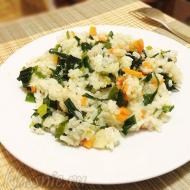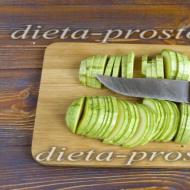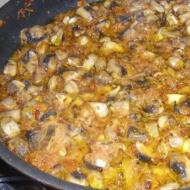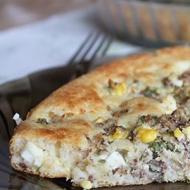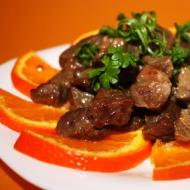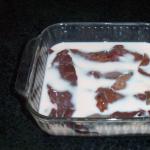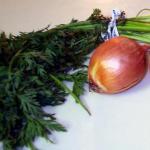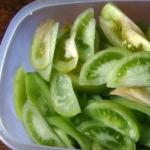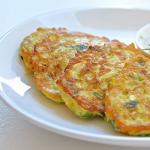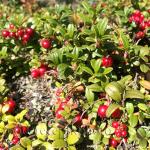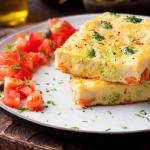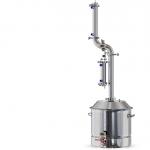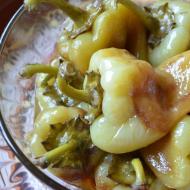
Amazing Coconut Flour (Gluten Free), Zucchini, Banana and Ginger Bread! Coconut bread free of gluten, flour, starch, yeast and sugar

However, if you do not have coconut, you can try to bake such a cupcake with ordinary milk and ready-made coconut flakes. I think that it will turn out also tasty, although not so authentic.

Baking coconut bread is convenient in a rectangular bread pan, which is probably why it is called Coconut Bread. As well as banana bread, which is shaped like a brick, although it also tastes more like a cupcake.

Take a form from 21 to 30 cm. In a smaller cupcake it will be higher, but it may take longer to bake. In a larger layer of dough, it will turn out lower. I baked in a 30x10 cm mold for 1 hour and 10 minutes. And you are guided by your oven.

Ingredients:
- 2 medium eggs;
- 300 ml coconut milk;
- 320 g flour (2 cups with a volume of 250 ml + 1 tablespoon);
- 180 g of powdered sugar;
- 150 g grated coconut;
- 2 teaspoons of baking powder;
- 2 teaspoons of cinnamon;
- Vanillin on the tip of a teaspoon;
- ¼ teaspoon salt;
- 75 g butter.
How to bake:
Melt the butter. We heat the oven to 180C.
The dough is prepared very simply: thoroughly mix the dry ingredients in one bowl: sifted flour, coconut, powdered sugar, salt, vanillin, baking powder and cinnamon.

In another bowl, beat the eggs with milk - with a mixer or whisk for half a minute.

Pour the milk-egg mixture into the dry, mix.

Pour the melted butter into the dough and mix again.

The dough turns out to be sparse in consistency, like sour cream. It looks like dough not for cupcakes, but rather for pancakes.

We cover the form with parchment, greased with vegetable oil. Pour out the dough.

Bake coconut bread on the middle floor of the oven until dry skewer, the exact time depends on the oven (1 hour - 1 hour 10 minutes).

We let the finished cake stand for 5 minutes in the form, then we take it out, remove the parchment and leave it to cool on a wire rack.

We could not resist and cut the bread still warm - to try. And what do you think? The four of us killed half! That's how delicious it is!

And especially if you spread a slice with butter and with a cup of milk, yum-yum ...
Well, you're here and recipes ponakidil! And what will surprise you now?
So:
Coconut milk-300ml (if there is no milk, it can be easily made from coconut flakes. Pour boiling water over the flakes so that it is covered. Leave to swell until it cools. Then squeeze the milk through a napkin (to make it easier to squeeze, chop the swollen chips with a blender). I , in fact, did just that.
Dry yeast - 1.5 tsp.
Flour c / s-3 cups (maybe a little more)
Brown sugar (you can use any) - 2 tbsp. l
Egg-1pc.
Vanilla - to taste
Coconut cake-50g
We dilute the yeast in half of the warm milk, add 2-3 tablespoons of flour and leave to rise. 
Beat eggs with sugar until foamy 
Mix the prepared dough with the egg, add the rest
milk 
Coconut pomace (remains after cooking milk) or just coconut flakes 
Vanilla and gradually add flour until you get a smooth dough. We grease our hands with vegetable oil. 
Let the dough rest until doubled in volume. 
I like to bake bread in small molds, so I divided the dough into 6 parts. Stretch each, then roll into a roll and roll up a snail 
Leave for proofing.
After proofing, brush with milk, sprinkle with coconut flakes 
Bake at 180 ° until golden brown (it is advisable to stay away from the kitchen, as the coconut-vanilla smell just blows the roof !!!)
Here are our loaves, light as fluff, (despite the fact that from
It's just something amazing! I have not been so happy with baking for a long time (well, from the last whole grain bread on yogurt 🙂), but this bread is simply a masterpiece!
The dough is prepared in almost 5 minutes, and the taste is simply fabulous! It's juicy and flavored with banana, coconut and ginger! Zucchini adds juiciness... Mmmmm, try it!
Coconut flour can be replaced with almond flour (not to be confused with almond crumbs and powder)
I’ll immediately write the BJU composition for a whole piece of this marvelous cake-bread:
Weight 480 grams turned out bread and
- 499 kcal.
- B-32 gr
- F- 27 gr.
- U-37 gr.
- and FIBER-32 grams!
I divided it into 8 pieces (so, visually) and it turned out 8 pieces of 60 grams.
1 serving 60 grams
- 62.37 kcal
- B- 4 gr.
- Zh-3.37 gr.
- U-, 37 gr.
- Fiber - 4 gr.
Super composition, right? 🙂
I baked in the evening, I wanted to bake it completely spontaneously, so there are no photos of the process (I’ll take a picture the next time I bake!)

For small bread (480 gr.) You will need:
- Coconut flour (or almond) -50 grams
- Milk 2.5% fat-50 ml.
- Chicken eggs - 3 pieces large or 4 medium.
- Banana-85 grams
- Zucchini-85 gr.
- Olive oil-8 gr. (I use walnut oil)-8 gr.
- Spoon a teaspoon of powdered ginger, or grate fresh ginger over a large tablespoon.
- Baking mix (baking powder or baking soda) teaspoon.
- Salt a pinch.

1. Preheat the oven to 190 C
2. Finely grate the zucchini and mash the banana pulp with a fork. Mix very thoroughly.
3. Beat eggs until thick foam.
4. Mix coconut flour with salt and baking mixture and powdered ginger, or add fresh ginger, finely grated in zucchini)
5. Add flour mixture to beaten eggs, mix thoroughly, mix with zucchini and banana, and add 50 ml of milk. Mix everything and at the end add walnut oil or olive oil 8 gr.
6. Put baking paper into a baking dish (rectangular) and press it against the walls of the form, put the mixture in and spread it over the bottom of the form.
7. bake at 190 C for 40 minutes until the top and sides of the bread are browned!
This is an awesome bread!
Firstly, it contains a minimum of carbohydrates, secondly, it has a lot of protein and fiber, and thirdly, it's just amazingly delicious cake bread! Much like a cake, but without the butter!

For several (two) months now, I have been deliberately avoiding gluten products. The doctor gave me a referral for a blood test for IgA antibodies to transglutaminase, but the test was negative. So she didn't believe me that I had an intolerance, but she said, "Whatever the child would not amuse You don't actually have celiac disease, but if you really want to, you can eliminate gluten from your diet." I poked her nose at an article about non-celiac gluten intolerance, but she shrugged. I had an idea to do a blind double test on a sample of one of me for gluten, but to be honest, it's broken. I already see for myself that even if I eat a little soy sauce, in which the cat cried flour, then for several days it seems like they cut me across with a blunt saw from the inside. And when we returned from Italy, where we ate pizza and pasta heartily, I writhed in agony for several weeks.
At first, I was terribly hungry without bread, so I baked gluten-free cookies, muffins, and pies non-stop. They are excellently obtained from almond flour, which, moreover, is rich in useful substances. But very expensive. The cheapest gluten-free flour is rice flour. You can also bake from it. It contains almost no nutrients and it has a high glycemic index, which is also not ice for me. And from the sweet I began to stir up in the end. I needed something to spread pate and eggplant sturgeon caviar on. I used to buy gluten-free bread from the store from time to time. Of all the brands I've tried, the only edible one is Schär, and it's also the most expensive. When a toad strangled me, I began to try to bake myself. The first timid attempts to make gluten-free bread gave inedible results. Moreover, in a panic, I also excluded yeast from the diet. And on one soda only cupcakes are obtained. Now the bread is so delicious that even JY sometimes eats it.
So, I share valuable knowledge. Since the post is long, I divided it into several categories, you can read only what you need.
bread maker
I make bread in a bread machine because gluten-free dough is much stickier than wheat, and I'm not a big fan of kneading dough by hand. And the bread machine itself kneaded, baked itself. And you don't have to wash extra dishes. I bought an almost new bread maker on leboncoin for 30 euros with a "gluten-free" mode, but, by and large, it is not needed. It is better to buy a programmable bread machine, but you can even the simplest one, which has the “dough kneading” and “baking” modes. In theory, the same recipes can be baked in the oven.
The most important thing in a bread machine: INSERT THE SPATULA BEFORE PLACING THE PRODUCTS! * Knead the dough for half an hour (I have a program called "pizza dough"). Then let it stand at room temperature until it rises about twice - up to a maximum of half a bucket. It will not rise to the height of a bucket, because gluten-free dough rises worse than wheat. Depending on the weather conditions in your kitchen, this can take from an hour to three. And then put to bake for an hour or two (my program is called "bake"). The baking time depends on the moisture content of the dough, and this is one of the technical problems that I have not yet figured out very well. Right now my dough is about as thick as this:
The result, IMHO, is rather dry:
Often in recipes you can find a recommendation to sift the flour so that it has more oxygen, which the yeast seems to need. I have not noticed a difference if I thump the flour with a glass or pass it through a sieve first. IMHO, the bread machine kneads so long and thoroughly that the dough is full of oxygen.
coffee grinder
In principle, all types of gluten-free flour can be bought ready-made. But sometimes it turns out cheaper or easier to grind food in a coffee grinder. For example, sunflower seeds, dry chickpeas / peas, millet can be bought almost everywhere, and you will have to run for flour from them. And flax seeds are much more sticky if ground just before cooking. So I also bought a coffee grinder.
Ingredients
Here is the most interesting. On the Internet you can find many recipes, the number of ingredients in which can easily reach up to twenty. The first time I opened these recipes, meditated and closed them back. In fact, the simplest bread can be baked from six basic ingredients:
1) water - 350 grams
2) olive oil - a tablespoon
3) dry yeast - sachet
4) rice flour - 300 grams
5) starch (potato, corn, tapioca - to choose from or in a mixture) - 150 grams
6) salt - 1 teaspoon
The ingredients are listed in the order in which you put them in the bread machine. In my bread maker, all the liquid ingredients are added first, then the dry ones. The most important thing in a bread machine: INSERT SPATULA BEFORE PLACING PRODUCTS!* If the yeast is not dry, it is advised to put it in a hole made in the center of the flour. Salt put as far as possible, preferably in a corner, so as not to interfere with the yeast at first. Often in recipes you can find a recommendation to sift the flour so that it has more oxygen, which the yeast seems to need. I have not noticed a difference if I thump the flour with a glass or pass it through a sieve first. IMHO, the bread machine kneads so long and thoroughly that the dough is full of oxygen.
Ratio water and flour is a difficult question. When I tried to add more water, the bread came out very wet, I had to dry it out in the toaster. But he was sticky. When I put in less water, the bread still didn't fully bake inside, even after two hours of baking. But in addition, it crumbled a lot and was difficult to eat. Everyone must decide this question for himself through trial and error.
Olive oil necessary for the smoothness of the dough, and so that it does not stick to the form.
Pro flour - a separate section.
Yeast necessary for the bubbiness of the dough. I tried to cook without them - with soda or eggs, but the bread turned out to be very dense and heavy and chewed with difficulty. There is another option to grow yeast if you do not trust store bought ones. More details - in the section "Sourdough".
Starch added for airiness and friability of the dough. In different sources, it is advised to put it as much as flour, or half. I chose the 2 to 1 option for myself - 300 grams of flour, 150 grams of starch. It seems that tapioca starch is the most useful, I don’t know why. Potato - the cheapest. I've used different ones and the taste is the same.
Salt
- they write that it is a necessary ingredient to stop the growth of yeast. I add it for flavor, even sometimes two tablespoons, because in gluten-free bread there is no such problem as "dough risen too much". I think to try adding it at the very last moment of stirring so that the yeast works longer and the bread rises more.
Flour
Rice
flour is not only the cheapest, but also the most neutral. It doesn't have any distinct taste. Part of the rice flour can be replaced with another to get a different flavor of the bread.
If you put just a little buckwheat
flour - 50 grams - then the bread will be dark in color and taste like rye or whole grain. Buckwheat is almost not felt. If more, then a strong taste of buckwheat, and I don’t like such bread.
I liked it very much millet
flour. And she's helpful. Gives bread a yellow color.
corn
not bad at times, but it quickly becomes boring. In addition, it contains few useful substances. It is inexpensive, you can add a little. Gives bread a yellow color.
Flour sorghum
I didn't like it at all. Gives bread a yellow color.
From ground pumpkin seed flour
mixed feelings. If you put a little bit (50 grams) - then ok. If more, then a very strange taste. Gives bread a dark color.
From almond
flour, I tried to make savory English muffins. I did not like. It makes excellent desserts, but it has too much nutty flavor in bread.
At purchased bread from chestnut flour
it tasted good. I probably put too much in the homemade bread and I didn't like it.
From coconut
flour I did only desserts. You have to be very careful with it, because it sucks up water like a sponge. If you do not add water, then the products are so dry that they are difficult to swallow.
Linen
flour is very viscous, and by itself cannot be used for cooking. It needs to be added as a binding agent.
My favorite mix is rice/millet flour for white bread and rice/buckwheat flour for dark bread.
There's also a bunch of flour that I haven't tried yet. Chickpea flour seems reasonable to me, especially since I really love all bean flours. It is rich in protein and minerals. I'm thinking of buying dry chickpeas and grinding them in a coffee grinder. I'm skeptical about soy flour. I have not tried amaranth flour, and did not come across. Quinoa has a specific taste, I suspect flour does too. Perhaps it should be put in moderation.
Often in recipes you can find a recommendation to sift the flour so that it has more oxygen, which the yeast seems to need. I didn't notice a difference if I churn the flour in a glass into a bread maker or put it through a sieve first. IMHO, the bread machine kneads so long and thoroughly that the dough is full of oxygen.
Gummy Substances - Gluten Replacement
Wheat flour is very sticky, which is not the case with gluten-free flour. Therefore, if you make bread from those basic ingredients. what I brought, it will crumble very much when cut and eaten into crumbs. To avoid this, a bunch of different exotic and not so products are added to the recipes.
Flax seeds - the easiest. You can also buy them already in the form of flour. I grind in a coffee grinder. A little, 25 grams, maximum 50. Pour in water, let stand, it turns out gruel. Subtract the amount of flour and water used from the total weight of flour and water.
chia seeds - more exotic. You can grind them up, or you can bang them like that. It's also best to pre-soak.
Can add eggs but I don't add .
Guar gum. Works great. The dough is sticky, similar to wheat. But it worried me. Is it not the same gluten, only in profile?
Xanthan gum. Same.
Locust bean gum - have not tried.
Psyllium husk - have not tried. Like fiber should swell and stick together.
apple fiber . Rubbed an apple on a combine. It stuck a little.
Vegetable fiber.
Also, to increase the viscosity in many recipes, it is advised to add grated vegetables - zucchini, carrots, pumpkin, celery. Since I often press vegetable juice, I have a lot of pomace left. I don’t know if vitamins remain in it, especially after cooking, but vegetable fiber is good for digestion.
Opara
In some recipes, it is advised to first knead the dough - a small part of water and flour (100/100 grams) with yeast and a spoonful of sugar, and wait ten minutes until the yeast starts to work, and then add all the other ingredients. It seems that the dough rises better. I didn't notice any difference with Quick Bookmark. You may have to wait longer than ten minutes.
Leaven
If you don't trust commercial yeast, or if you want a more complex, sour bread flavor similar to rye, you can make your own sourdough. There are many different complex and not very recipes on the Internet. The simplest: add the same weight of water and flour every day. Do not forget to close the container, you can cover it with cling film, otherwise flies will fly in.
Since yeast lives everywhere, they will start to multiply by feeding on flour. The air is also full of lactic acid bacteria. First it will smell like acetone, then fermented fruit or wine, and fruit flies will fly in. After about a week or two, the dough will smell like dough and begin to bubble and rise. I added about 50 grams of water and flour every day (some advise even twice a day), but very quickly this thing got out of a liter container, because it also grows up. It is necessary to either take a large container, or divide it into two containers, or now I have restarted the process and try to put a smaller one.
When making bread, replace some of the water and flour with sourdough. For example, if you put 300 grams of sourdough, subtract 150 grams of water and 150 grams of flour from the recipe. Feed the rest of the starter again with flour and water, and put the refrigerator. It seems that she can live there indefinitely (I have not tried it), if once a week she is given flour and water. Before cooking bread, take it out of the refrigerator, add flour and water, and let it grow for 12 hours. In a bread machine, it is advised after kneading to let the dough rest at room temperature until it doubles in size, which can take from three to eight hours.
I liked the taste of this bread much more than yeast bread.
Additional Ingredients
If you've already mastered the kung fu of the first gluten-free bread, there are more tips on how to complicate the recipe to get closer to perfection.
Some recipes advise you to put a spoon Sahara into the ingredients so that the yeast grows more actively. I didn't notice any difference with or without sugar.
For taste and increase the usefulness of bread, you can add sunflower seeds, sesame seeds, cumin, pumpkin seeds, whole flax seeds .
It seems to be vitamin C improves yeast performance and dough stability. Have not tried.
Some recipes advise adding more soda for the airiness of the dough. I didn't notice a difference, but I need to take a closer look.
Vegetable fiber.
Also, to increase the viscosity in many recipes, it is advised to add grated vegetables - zucchini, carrots, pumpkin, celery. Since I often press vegetable juice, I have a lot of pomace left. I don’t know if vitamins remain in it, especially after heating, but vegetable fiber is good for digestion.
That, in fact, is all that I wanted to tell about the war in Vietnam. If you have additions, questions, recommendations, I am open for communication.
* what i always forget to do

